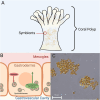Saving coral reefs: significance and biotechnological approaches for coral conservation
- PMID: 39883363
- PMCID: PMC11740877
- DOI: 10.1007/s44307-024-00049-1
Saving coral reefs: significance and biotechnological approaches for coral conservation
Abstract
Coral reefs are highly productive ecosystems that provide valuable services to coastal communities worldwide. However, both local and global anthropogenic stressors, threaten the coral-algal symbiosis that enables reef formation. This breakdown of the symbiotic relationship, known as bleaching, is often triggered by cumulative cell damage. UV and heat stress are commonly implicated in bleaching, but other anthropogenic factors may also play a role. To address coral loss, active restoration is already underway in many critical regions. Additionally, coral researchers are exploring assisted evolution methods for greater coral resilience to projected climate change. This review provides an overview of the symbiotic relationship, the mechanisms underlying coral bleaching in response to stressors, and the strategies being pursued to address coral loss. Despite the necessity of ongoing research in all aspects of this field, action on global climate change remains crucial for the long-term survival of coral reefs.
Keywords: Climate change; Conservation; Coral; Coral bleaching; Resilience; Symbiosis; Zooxanthellae.
© 2024. The Author(s).
Conflict of interest statement
Declarations. Ethics approval and consent to participate: Not applicable. Consent for publication: The work described has not been published before and is not under consideration for publication elsewhere. All co-authors have approved the final version. Competing interests: Author Z.D. is a member of the Editorial Board for Advanced Biotechnology, and the author is not involved in the journal’s review and decisions related to this manuscript.
Figures




Similar articles
-
Reef on the edge: resilience failure of marginal patch coral reefs in Eastern Arabian Sea under recurrent coral bleaching, coral diseases, and local stressors.Environ Sci Pollut Res Int. 2023 Jan;30(3):7288-7302. doi: 10.1007/s11356-022-22651-3. Epub 2022 Aug 29. Environ Sci Pollut Res Int. 2023. PMID: 36031676
-
A roadmap to integrating resilience into the practice of coral reef restoration.Glob Chang Biol. 2022 Aug;28(16):4751-4764. doi: 10.1111/gcb.16212. Epub 2022 May 19. Glob Chang Biol. 2022. PMID: 35451154 Free PMC article.
-
The engine of the reef: photobiology of the coral-algal symbiosis.Front Microbiol. 2014 Aug 22;5:422. doi: 10.3389/fmicb.2014.00422. eCollection 2014. Front Microbiol. 2014. PMID: 25202301 Free PMC article. Review.
-
Assessing the potential for demographic restoration and assisted evolution to build climate resilience in coral reefs.Ecol Appl. 2022 Oct;32(7):e2650. doi: 10.1002/eap.2650. Epub 2022 Jun 27. Ecol Appl. 2022. PMID: 35538738 Free PMC article.
-
Operationalizing resilience for adaptive coral reef management under global environmental change.Glob Chang Biol. 2015 Jan;21(1):48-61. doi: 10.1111/gcb.12700. Epub 2014 Sep 5. Glob Chang Biol. 2015. PMID: 25196132 Free PMC article. Review.
References
-
- Adir N, Zer H, Shochat S, Ohad I. Photoinhibition - a historical perspective. Photosynth Res. 2003;76(1-3):343-70. 10.1023/A:1024969518145. - PubMed
-
- Ainsworth TD, Brown BE. Coral bleaching. Curr Biol. 2021;31:R5–6. 10.1016/j.cub.2020.10.048. - PubMed
-
- Ainsworth TD, Gates RD. Corals’ microbial sentinels. Science. 2016;352:1518–1510. 10.1002/2015GL067189. - PubMed
Publication types
Grants and funding
LinkOut - more resources
Full Text Sources
